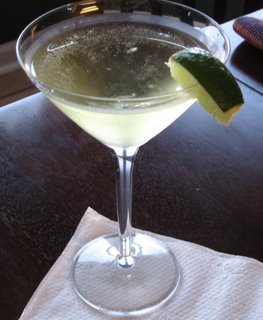
Like many mystery buffs, I was introduced to the gimlet while reading Raymond Chandler's classic detective novel The Long Good-Bye. In the story, private eye Philip Marlowe and a dissipated playboy named Terry Lennox create an uneasy bond over gimlets at Victor's bar, and after Lennox's supposed death Marlowe drinks the cocktail as a sentimental remembrance of their lost friendship.
The gimlets Lennox and Marlowe drank weren't the real thing, as Lennox himself points out:
Gimlets weren't in the first draft of the Long Good-Bye. In 1952, as Chandler was revising the novel to prepare it for publication, he and his wife took a month-long trip to London. He discovered the gimlet--and the British way of making it with Rose's Lime Juice--on the return voyage from England on The Mauretania, and he liked it so much that he worked it into the final version of the novel.We sat in the corner bar at Victor's and drank gimlets. "They don't know how to make them here," he said. "What they call a gimlet is just some lime or lemon juice and gin with a dash of sugar and bitters. A real gimlet is half gin and half Rose's Lime Juice and nothing else. It beats martinis hollow."
Chandler's recipe of 1/2 gin and 1/2 Rose's seems a bit steep, since a gimlet is basically a martini with Rose's rather than vermouth. The 1954 Esquire's Handbook for Hosts, published in London in 1954, cites the Savoy Hotel's recipe as using a ratio of 3 parts gin to 1 part Rose's. Esquire also notes, "A true Gimlet must be made with Rose's bottled lime juice, which vanished like nylons during the war but is now seen around again."
Many recipes today still call for lime juice mixed with powdered sugar, and some call for lemon juice, but these are poor subsitutes for Rose's Lime Juice, which has a pale yellow color and sweet, candy-like taste that is hard to duplicate. The product has its roots in the 19th Century, when British sailors were required by law to take a daily dose of lime juice to prevent scurvy. Laughlin Rose, an Edinburgh shipping provisioner, formulated the original lime-and-sugar syrup in the 1860s as an alternate way to preserve limes, which previously were packed in a 15% alcohol solution. Rose's Lime Juice proved popular with the general public as well, and today is a bar staple distributed by the Cadbury Schweppes company.
The origin of the gimlet itself is uncertain, but it became popular as a thirst quencher in the tropical British colonies in the early part of the century, and it took hold in London as well during the 1920s and 30s. For Chandler fans, gimlets will always be a sentimental drink, conjuring up a sense of melancholy and loss. They are best drunk in a cold, dark bar while it's hot, hot outside, recreating Marlowe's moments of cool reflection amid the sunblind heat of the Los Angeles summer. But, they're good on the back porch or in a beach house, too, the tart lime juice with its sweet undertones a perfect accompaniment to a warm summer day.
Recipe
Put 2 oz. good gin and 2/3 oz. Rose's Lime Juice in a cocktail shaker with lots of ice. Shake well, pour into a martini or highball glass, and garnish with a lime twist or slice.



3 comments:
Super color scheme, I like it! Good job. Go on.
»
Your are Excellent. And so is your site! Keep up the good work. Bookmarked.
»
that was great info, gimlets just became my drink of choice and I've been introducing them to a lot of friends. Ps, I prefer mine with kettle one vodka.
Post a Comment